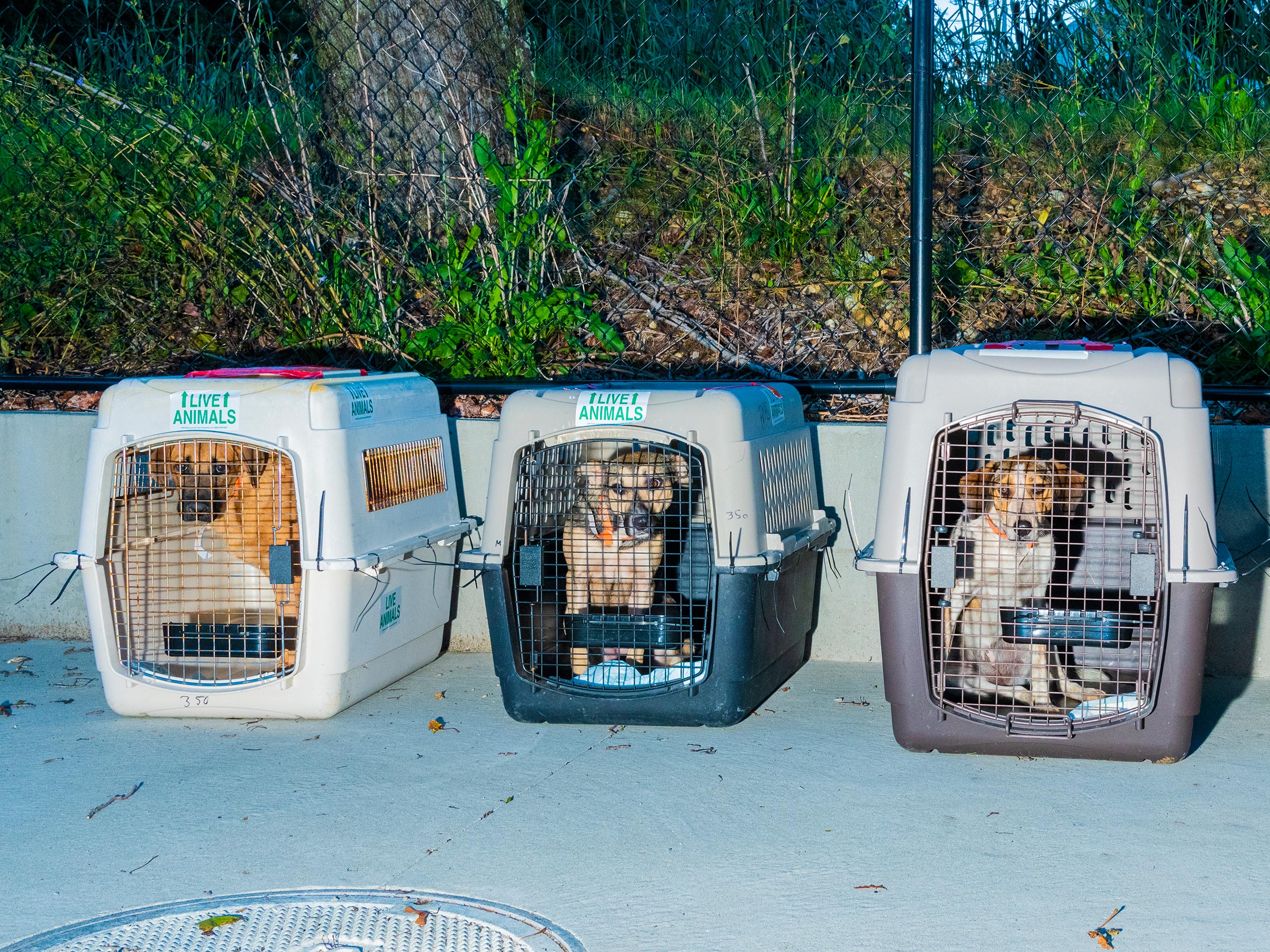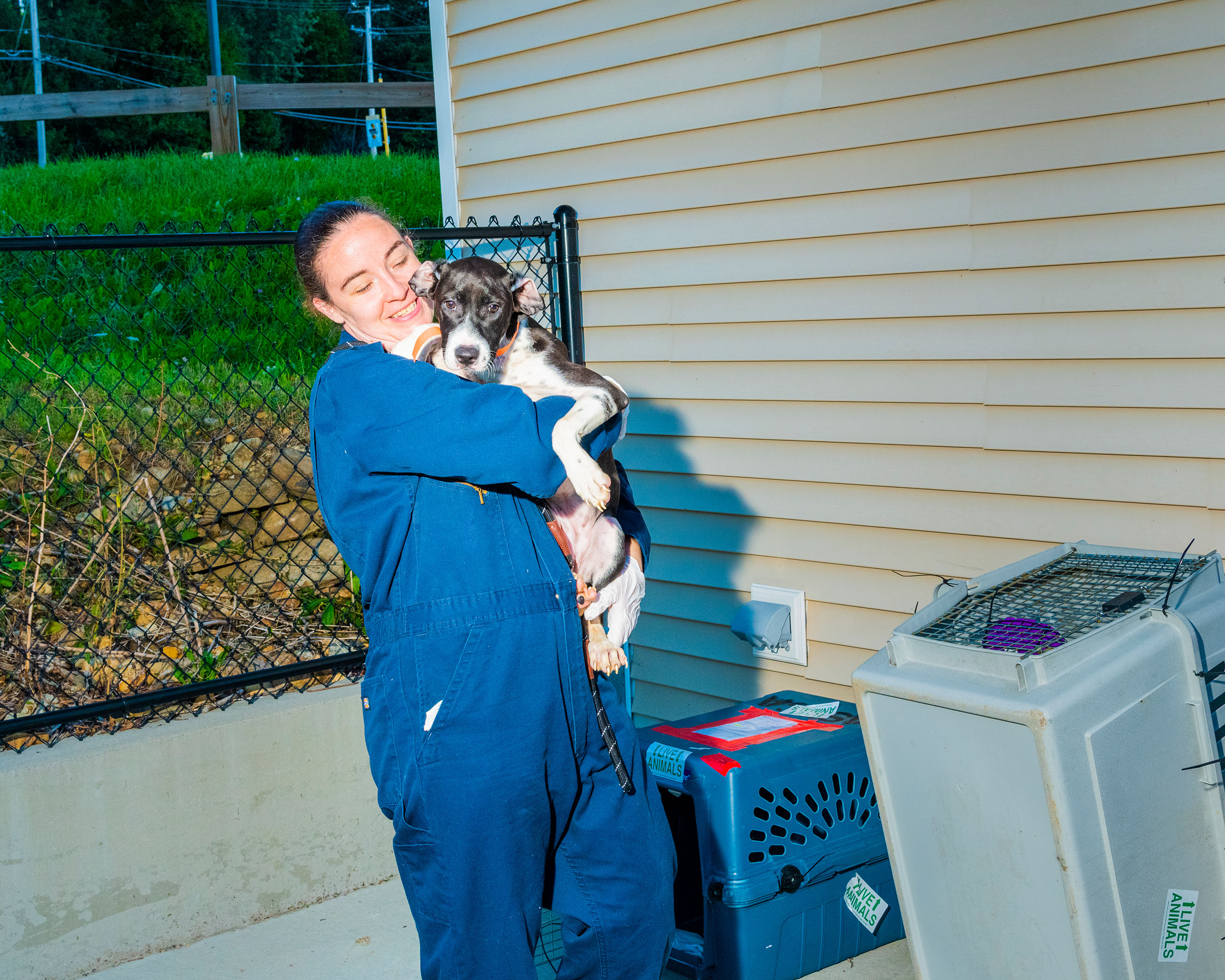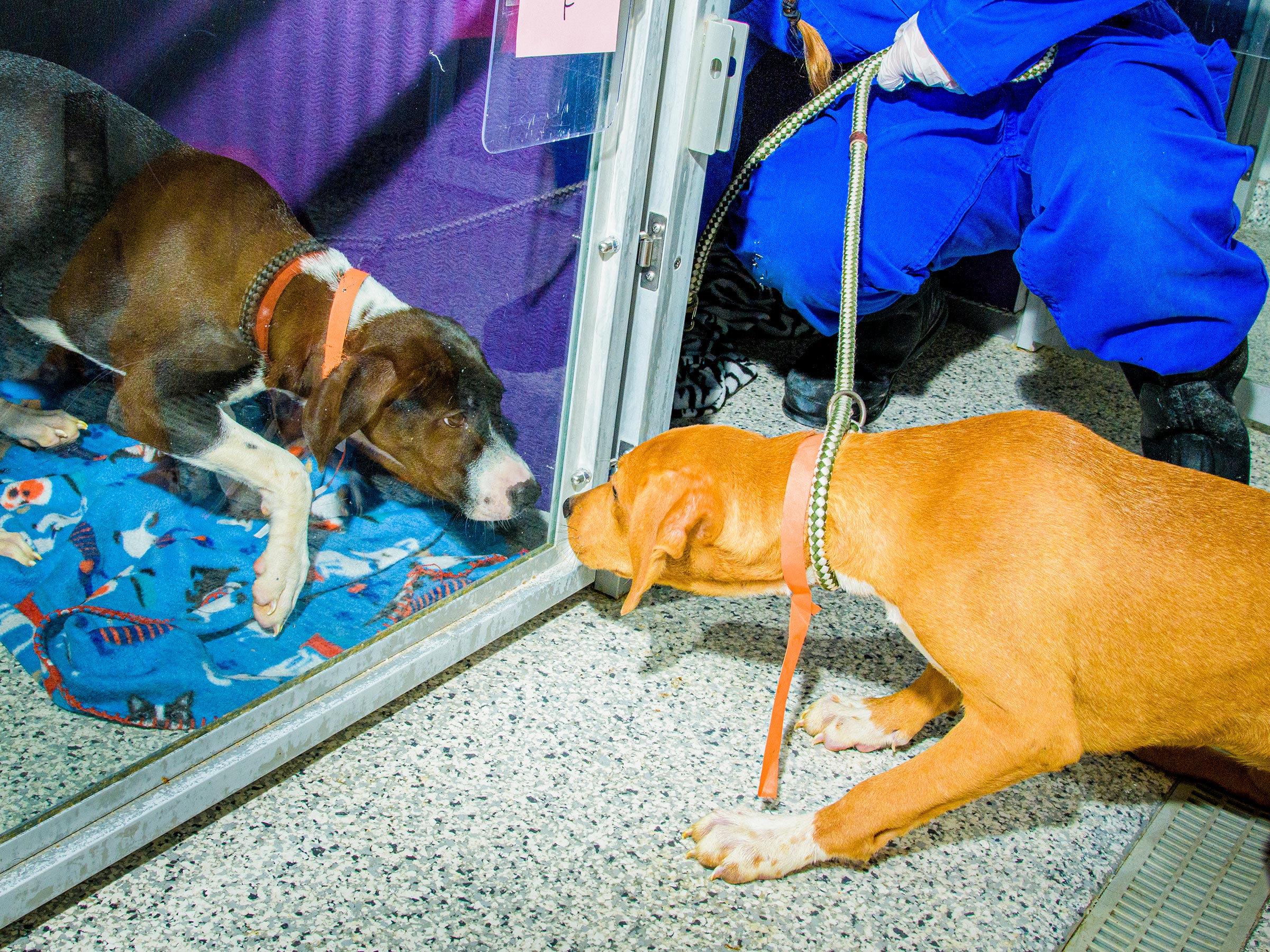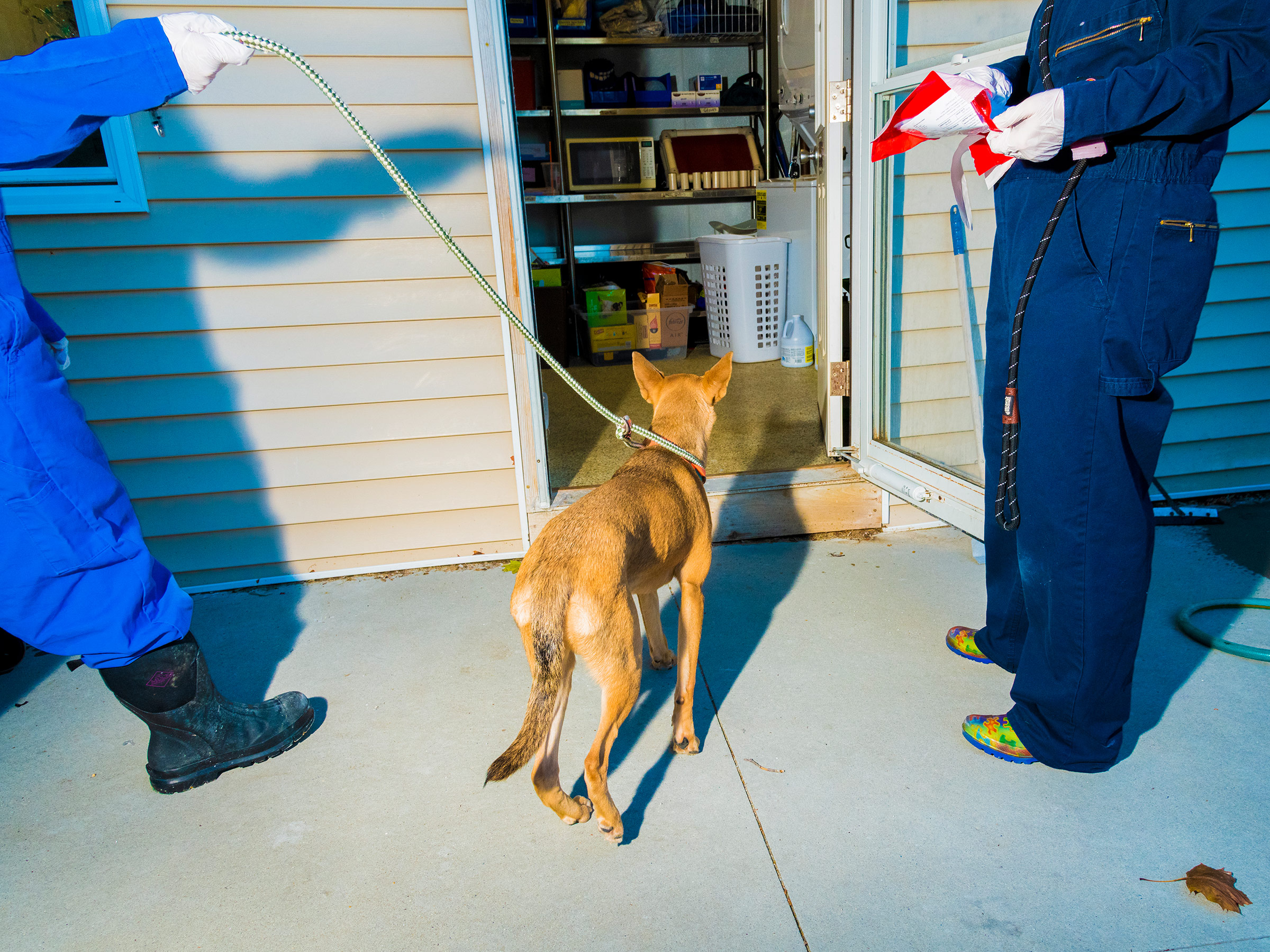What Is Different About The Spca Than Any Other Animal Shelter
The dusty white cargo airplane stood out amongst the gleaming corporate jets, as did its passengers: 48 barking dogs, newly arrived at the private air terminal at Hanscom Field, outside of Boston.
They had left Mississippi that morn with their health certificates taped to their kennels. All week, the staff at Oktibbeha County Humane Club (OCHS), in Starkville, Miss., had been getting them ready, giving them their shots, testing their temperaments, and color-coding each crate for its destination: red for Second Take chances Creature Services in North Brookfield, Mass.; grayness for the Fauna Rescue League of Boston; and blue for the MSPCA, an independent animal-welfare organization.
On the tarmac, representatives from each jostled around the animals similar vacationers at luggage claim. Danielle Bowes, a staff member at Second Take a chance, checked her list. She was looking for 2 tiny puppies named Tiger and Presley; black and brown 4-month-olds Brigand, Josie, and Wells; an adult lab mix, Trent; and a dozen more, ranging from 8 lb. to 40 lb., from 8 weeks to four years old. When she institute Bravo, a 1-yr-old collie and American blue heeler mix, she cooed into his cage, "How-do-you-do, Pretty, you're going to go quick!" Back at 2d Chance, the dogs will quarantine for 48 hours, per state law, before they go upwards for adoption. If past experience is any guide—and transports like this arrive nearly every calendar week all over the country, by airplane, truck, and van—they volition be gone in a few days, becoming the newest of the estimated 90 million canines living with U.S. families.
In that location is not a dog shortage in America—not yet, at least. But at that place are stark geographic differences in supply and demand. Massachusetts needs more dogs, and Mississippi has too many. The same is truthful of Delaware and Oklahoma, Minnesota and Louisiana, New York and Tennessee, and Washington and New Mexico, among other states. To compensate, sophisticated canis familiaris–relocation networks have sprung upward over the past decade, transporting dogs and cats from states with too many to states with also few. Mostly, it's a tactical problem: "How exercise we connect those shelters that have likewise many animals and are at risk of euthanasia simply considering they were built-in there, to those shelters where these animals are gonna fly off the shelves?" says Matt Bershadker, CEO of the ASPCA, the New York–based animal-welfare giant, which sponsored and organized the flying arriving at Hanscom. Over the by five years, the ASPCA has poured resources into its "relocation" program, which in March volition celebrate its 200,000th brute moved. But it is far from solitary.
These pipelines of adoptable animals—primarily, but not exclusively, moving from southward to due north—have become a cultural phenomenon in their own correct, and a key role of a broader transformation of companion-animal welfare. The ASPCA'south plan may be the biggest and nigh organized, but dogs (and, to a lesser extent, cats) move by all sorts of other means. There are ad hoc bands of volunteers, organizing on Facebook and Petfinder, who encompass their dorsum seats with towels and rendezvous at balance stops, passing animals along every couple hundred miles. In big cities and their suburbs, nonprofits accept sprung up to partner with overcrowded Southern shelters, hire a driver and load upwardly a van with a few dozen animals every month or more. During the COVID-19 pandemic, many of these groups became overwhelmed with need in some states, leading to months-long waiting lists and stiff competition amid adopters. That spurred a surprising fourth category: veritable smugglers, who saw an opportunity in loading up a horse trailer with the cutest strays and driving north (leaving the nonprofits with the ill and less desirable animals).

Wells, four months, Millie, 4 years, and Coralie, one year, wait to exist moved from their travel kennels into quarantine at Second Hazard Animate being Services
Evan Angelastro for Time
It is a good time to be an American dog. In the 1970s, equally many as 20 meg dogs and cats were euthanized each yr. That number has declined precipitously. The ASPCA at present estimates 390,000 dogs and 530,000 cats are euthanized each twelvemonth, downwards from 2.vi million as recently as 2011. That'due south still besides many—especially when a fashion to further reduce the number is at mitt. Euthanasia was once seen as an inevitability: at that place were only besides many animals. Merely a combination of factors—cultural, medical, and political—has changed that. More than people want mutts, rebranded "rescues." Fewer animals are born each year, thanks to broader spay and neuter programs, often dictated by law, and improved surgical techniques. And more than are beingness moved, which helps relieve those animals, but also opens up space and time to intendance for others left behind. For shelter staff, who endure from a unduly high rate of mental-health issues, nix matters more than keeping up with their animals' needs. Rather than being beaten down by the incessant necessity of euthanizing the unwanted, they are buoyed by a steady flow of adoptions.
Coin helps, of course. The geographic disparities that lead one place to accept too many dogs and some other too few are primarily fueled past a difference in resource. Shelters in heavily populated cities and suburbs benefit from well-funded population-control programs and large pools of potential adopters. Shelters in rural areas struggle with excess animals, and communities with broader economic burdens. Puppies flying private may seem excessive—the flight into Hanscom cost the ASPCA approximately $30,000—but the kennels on the tarmac amid the corporate jets are an indicator of the broader success of the animal-welfare movement, and the enthusiasm of its donors. The easy problems are nearly solved; the hard ones crave a new approach. "Animal relocation" is not just about meeting demand for puppies, but also building the capacity to help all animals.
The ASPCA-sponsored flight exemplifies an organized endeavour to connect disparate communities in pursuit of a mutual goal. It is a living, breathing—barking, panting—geographic arbitrage. Simply by treating these flying puppies every bit points of connection between communities, similar the knots in a net, the effect of excess animals can be addressed. It'south a recognition that some problems, fifty-fifty ones that span red states and blue states, can be solved together.
When Michele Anderson first volunteered at the Oktibbeha Canton Humane Society, its challenges could be measured with a simple formula. Like many shelters, it calculated its "live-release rate": the number of animals that left alive, divided by the total number that came in through the door. In 2009, it hovered effectually fifty%. "I recall if we had a cat that sneezed, we didn't keep the cat," Anderson recalls. New animals filled the door of the shelter every twenty-four hours, and there was neither the space to business firm them nor the money to pay the staff to take intendance of them. But Anderson saw a way to modify that.

Danielle Bowes, a care and adoption advisor at Second Chance, moves Zelda from the crate she flew in
Evan Angelastro for Fourth dimension
OCHS occupies a tidy brick business firm on the industrial edge of Starkville, the thriving home of Mississippi State University. Within, every inch is devoted to animals and their intendance, with barking dogs and prowling cats behind every door and supplies stacked in every corner. Outside, a fenced-in green-grass backyard gives the dogs a place to play. But the social heart is the atomic number 26 bench on the petty porch out front, frequently busy with chatting veterinary students from the university and volunteers.
It was there that Anderson, who had joined the shelter'due south board of directors, oversaw the arrival of a transformative visitor: the "Rescue Waggin'," a green van with a giant puppy decal on the side. It belonged to PetSmart Charities, the philanthropic arm of the pet-store chain. The first year it came to Oktibbeha, in 2009, it picked up 40 animals, a handful at a fourth dimension, and transported them to places similar Kansas Metropolis and Chicago. Over the adjacent few years, the Rescue Waggin' raised that to several hundred. "Just it actually wasn't doing anything," Anderson says. Information technology wasn't addressing the broader challenge in the customs.
OCHS was far better resourced than many of its Mississippi neighbors. Information technology had the social capital of the university to draw on, and a contract with the city of Starkville to accept in strays. By many measures, Mississippi is the poorest state in the U.Due south., and in nearby communities "animal control" was more likely to exist a fenced-in area alongside the boondocks dump or behind the sheriff'southward department. OCHS had professors of veterinary medicine advising on best practices, merely places similar Winston County, 25 miles away, struggled to provide basic necessities to the animals in its care.
Anderson, who works as an ambassador at the university, saw a way for OCHS to "step up our game": they would transport in more than animals. At commencement, information technology seemed anathema: the goal was to accept fewer. Merely if OCHS could human activity as a hub, consolidating the work it took to prepare animals for transport, it could reap the rewards of book. "Instead of Rescue Waggin' coming down for five animals, we were able to fill the entire truck," says Anderson. They began working with partner organizations to bring in more than dogs; and a growing list of transport partners to transport dogs out. From 2009 to 2019, OCHS' live-release rate skyrocketed from l% to 95%; rather than euthanizing every other animal, information technology constitute homes for all just 1 in xx. Final year, the little shelter sent out one,842 dogs and 844 cats on transports, almost ii-thirds of which came in from partner organizations. "If nosotros didn't have transport, it would exist devastating for us and the groups we work with," says Anderson. "Information technology's transformed the lives of these animals, and the people who are dealing with these animals—because now they have some sort of hope."

Four-month-erstwhile siblings Zelda, left, and Zara, correct, traveled together from Mississippi to Massachusetts
Evan Angelastro for TIME
On the other terminate, there are enough of shelters eager to receive them. Sheryl Blancato, founder and executive director of 2d Chance Animal Services—1 of the shelters that met the flight in Massachusetts—remembers, around 2007, when her kennels began to empty out. "We noticed that nosotros started to have space," Blancato recalls. From the street, the Massachusetts and Mississippi facilities don't seem that different; like its Southern counterpart, 2d Take a chance occupies a converted house on the edge of boondocks. But whereas OCHS had (and still has) an endless stream of new arrivals, by the mid-2000s, Second Take chances began seeing far fewer. Blancato started driving downwards overnight to Virginia or Maryland, returning with a full van. She saw how the adorable new arrivals increased foot traffic at the shelter, which in turn increased the likelihood that the harder-to-love, or the older-and-larger, would find homes.
Blancato's feel tracked a broader transformation in American dog civilization. Animal welfare used to be animal command: the canis familiaris catcher of lore. (Information technology's how Blancato got her showtime.) Individual shelters began to pop up in the 1980s and '90s. Petfinder, the ubiquitous classifieds site for adoptable dogs, was founded in 1996—right on the heels of Craigslist and Match, the year before—and similarly revolutionized how people found pets. In 2005, Hurricane Katrina galvanized beast welfare, as evacuees' despair over their abased pets showed how much companion animals meant to people. In response, Congress passed the PETS Act in 2006, which required local governments to accommodate family pets in their disaster planning. In 2007, the ASPCA aired its famous "Angel" commercial, with vocalist Sarah Mac-Lachlan asking viewers to give a "second chance" to an "creature in a shelter correct at present." Astonishingly, it lone raised $30 million for the ASPCA in its starting time two years, and helped cement the image of a "rescue dog" as a virtuous practiced, rather than a nuisance. By the time Insta-gram launched in 2010, and the oldest millennials turned xxx and began adopting their own animals (and giving them their ain accounts), #AdoptDontShop was a motility. In the 1990s, fewer than x% of dogs were adopted from shelters; today, that number has grown to nearly 30%.
That steady increase in demand coincided with a decrease in supply. Effectually the aforementioned fourth dimension, in the late 2000s, veterinarians launched a concerted effort to spay and neuter more dogs and cats. The strategy was in part technique: vets developed ways of performing the surgery faster. They could set upward associates-line clinics, bringing down the cost per beast. Just information technology was also police force: 32 states now require that an animal be sterilized before it is released from a shelter. Information technology exponentially reduced the number of animals born outside of deliberate breeding. Puppies became deficient.
Not in Mississippi. Dr. Phil Bushby, one of the more than prominent proponents of the national spay/neuter efforts, teaches at Mississippi State. He thinks of this coaction between surgery and ship like a faucet flooding a basement. "Transport is bailing h2o out of your basement," he says. "Spay/neuter is turning the faucet off. You have to do both."
Presley, 8 weeks, left, and Hazel, xviii months, will be adopted immediately
Evan Angelastro for Fourth dimension
On a crisp Mississippi afternoon with a deep blue sky, Camille Cotton sits in front of two computer monitors inside her office, a lilliputian red brick building at the edge of the OCHS parking lot. Think Pawsitive, says the plaque above her desk. Each calendar week, sometimes several times a week, Cotton fiber organizes the transports. She starts with a blank spreadsheet and begins assembling her manifest, cartoon on the animals waiting at OCHS for their ticket out, or checking in with any of 3 dozen partner organizations to run across who might be "transport eligible." When Cotton texts, they answer immediately. If she takes their dog, it frees up a crowded kennel, with the assurance that the animal will go on to a skilful life. "They're all pets, they're merely homeless," Cotton fiber says. "They just demand somewhere to go."
Some come up with scars, others with stories. Elmer Fudge, a 1-twelvemonth-old hound mix, was the largest on Cotton's list that day, at 49 lb. He'd arrived at OCHS a couple weeks earlier as a stray, and the staff now knew him well. "Elmer Fudge is gear up to lick your confront and smell your yard," noted the last cavalcade of Cotton's spreadsheet. The mix is crucial, like a box of bonbons, "but sometimes information technology's not that easy," Cotton fiber says. "Anoint their hearts they might all exist black and brown." Joyce, a three-year-old pit bull mix, is white, and traveling with four of her 2-month-old puppies. "Joyce is a sugariness soul," notes the manifest. "She has been through so much." Joyce and her pups were among 19 animals seized from a dwelling house where a murder took place. Cotton tries to stay dispassionate. "The ones at OCHS, we know each other," she says, "but you can't have favoritism on ship, considering yous can lose sight of what's best for the dog, and what'due south best for the source shelter, and what'due south best all around."
The ASPCA precisely manages the movements of its 18 vans, which run northward full and due south empty. Information technology besides sets strict requirements for how both source and destination shelters participate in the relocation plan. Everyone needs to follow the ASPCA's thick portfolio of "standard operating procedures," roofing everything from how the dogs are tagged earlier divergence to keeping track of which destination states require which heartworm preventatives. As much as anything, the shared procedures help build connections between the source and destination communities. Rather than well-resourced Northern shelter workers shaking their heads at the poor handling of animals past their Southern colleagues, the programme gives everyone a improve understanding of their shared challenges. When possible, they visit one another. "Have them walk a mile in their shoes, because there's nada like that," says Heather Cammisa, sometime president and CEO of St. Hubert'south Animal Welfare Center in New Jersey. "They're already getting their teeth kicked in, just on what they have to deal with every day."
Read More: Some Workers Are Choosing Their Pets Over Their Jobs As Offices Reopen
Over time, the shelters that needed the most help find themselves in a position to help others. At the ASPCA, they call information technology "pushing the line": when the problem of animal overpopulation is solved in one place, information technology can be meaningfully addressed in the side by side. "What we're starting to run into is shelters that started as sources of dogs for united states, become aggregators of dogs for their own communities," says the ASPCA's Bershadker. When OCHS brings in good for you animals from around the region, those rescues tin devote more than energy to their struggling animals. "It's definitely a domino effect, where we help them, they get help from their community, and it evolves," says Anderson.

Cheyanne Gustafson walks Hazel into quarantine at 2nd Chance Creature Services
Evan Angelastro for TIME
Cotton'south group was headed from OCHS to Wayside Waifs, a shelter in Kansas Urban center, Mo., around 600 miles away. Each month, Karen Walsh, ASPCA's senior director of animal relocation, creates a transport calendar with her team. They poll the destination shelters on how much infinite they have; confirm that the source shelters don't have any health bug, like a distemper outbreak; and plan the routes. The ASPCA operates five "Way-stations," overnight rest stops that serve as dog motels for their transport plan, in Kentucky, Tennessee, Virginia, California, and Kansas—each serving shelters inside a 650-mile radius. "Information technology's a costly program because we do information technology that way, but it's a very safe plan because we do it that way," Walsh says.
They talk virtually someday putting themselves out of concern. The end point would be when a combination of transport and population control balances supply and demand, and animals are no longer euthanized for space in America. The adjacent take a chance, however, is a shortage of dogs that spurs unsafe puppy breeding. That prospect has some discussing the possibility of shelters in high-demand areas starting their own breeding programs. For those who vividly recall the era of loftier euthanasia rates—much less those who are still living information technology—it'due south a shocking idea, similar a cocktail hr at rehab. But, its proponents argue, encouraging more than salubrious "American mutts" could be an culling to allowing commercial puppy breeders to see the public need for animals.
The adjacent morning, a crescent moon hangs over the Mississippi predawn. After a nighttime at the Hampton Inn, the ASPCA's drivers, Mel Rock and Jess Tippie, beep the van back up to the OCHS door. The staff gathers around, and Tippie checks the paperwork on an iPad and shuffles the printed rabies certificates in plastic sheaths. "All the wellness certs were good?" Rock asks.
Then the dogs start coming. A 20-year-onetime volunteer cradles Button, a tiny dachshund she'south been fostering at home for ten days. Stone and Tippie had already labeled the crates strapped into the back of the van, determining in advance where each animal would go. Their moves are all choreographed and codified by the ASPCA, from endmost the van door while each fauna is loaded in, to changing out their surgical gowns and gloves to forestall the spread of any illness. Andrea Spain, a professor of English at the university who runs her own small rescue, brings over Mo, a 9-month-old Rottweiler mix, who jumps in circles. Rock fills a crimson watering can with bottled water, then slips its thin spout through the mesh crate doors, filling each fauna's bowl for the all-mean solar day journey.
Information technology's 38 dogs in total, and as well a webbing of ties betwixt communities—in Starkville, in Mississippi as a whole, at the destination shelter in Kansas City, and wherever the dogs stop up. When the truck leaves, OCHS has space for 20 new animals. Non for long. "No sooner than nosotros go a couple of kennels open, here comes a newbie!" Cotton says. "There is a door they open somewhere and it'southward just like … Who let the dogs out?"
Blum is the author of The Weather Machine and Tubes: A Journey to the Centre of the Net
Source: https://time.com/6144366/dog-adoption-relocation-aspca/
Posted by: ingramfaies1970.blogspot.com

0 Response to "What Is Different About The Spca Than Any Other Animal Shelter"
Post a Comment